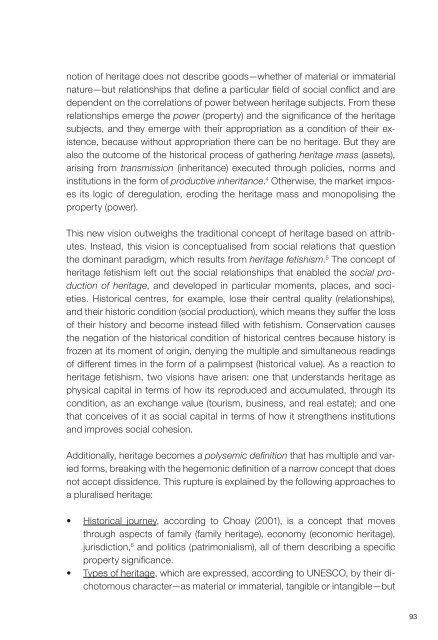Creative Heritage
ISBN 978-3-86859-532-1 https://www.jovis.de/de/buecher/product/creative-heritage.html
ISBN 978-3-86859-532-1
https://www.jovis.de/de/buecher/product/creative-heritage.html
You also want an ePaper? Increase the reach of your titles
YUMPU automatically turns print PDFs into web optimized ePapers that Google loves.
notion of heritage does not describe goods—whether of material or immaterial<br />
nature—but relationships that define a particular field of social conflict and are<br />
dependent on the correlations of power between heritage subjects. From these<br />
relationships emerge the power (property) and the significance of the heritage<br />
subjects, and they emerge with their appropriation as a condition of their existence,<br />
because without appropriation there can be no heritage. But they are<br />
also the outcome of the historical process of gathering heritage mass (assets),<br />
arising from transmission (inheritance) executed through policies, norms and<br />
institutions in the form of productive inheritance. 4 Otherwise, the market imposes<br />
its logic of deregulation, eroding the heritage mass and monopolising the<br />
property (power).<br />
This new vision outweighs the traditional concept of heritage based on attributes.<br />
Instead, this vision is conceptualised from social relations that question<br />
the dominant paradigm, which results from heritage fetishism. 5 The concept of<br />
heritage fetishism left out the social relationships that enabled the social production<br />
of heritage, and developed in particular moments, places, and societies.<br />
Historical centres, for example, lose their central quality (relationships),<br />
and their historic condition (social production), which means they suffer the loss<br />
of their history and become instead filled with fetishism. Conservation causes<br />
the negation of the historical condition of historical centres because history is<br />
frozen at its moment of origin, denying the multiple and simultaneous readings<br />
of different times in the form of a palimpsest (historical value). As a reaction to<br />
heritage fetishism, two visions have arisen: one that understands heritage as<br />
physical capital in terms of how its reproduced and accumulated, through its<br />
condition, as an exchange value (tourism, business, and real estate); and one<br />
that conceives of it as social capital in terms of how it strengthens institutions<br />
and improves social cohesion.<br />
Additionally, heritage becomes a polysemic definition that has multiple and varied<br />
forms, breaking with the hegemonic definition of a narrow concept that does<br />
not accept dissidence. This rupture is explained by the following approaches to<br />
a pluralised heritage:<br />
• Historical journey, according to Choay (2001), is a concept that moves<br />
through aspects of family (family heritage), economy (economic heritage),<br />
jurisdiction, 6 and politics (patrimonialism), all of them describing a specific<br />
property significance.<br />
• Types of heritage, which are expressed, according to UNESCO, by their dichotomous<br />
character—as material or immaterial, tangible or intangible—but<br />
93


















